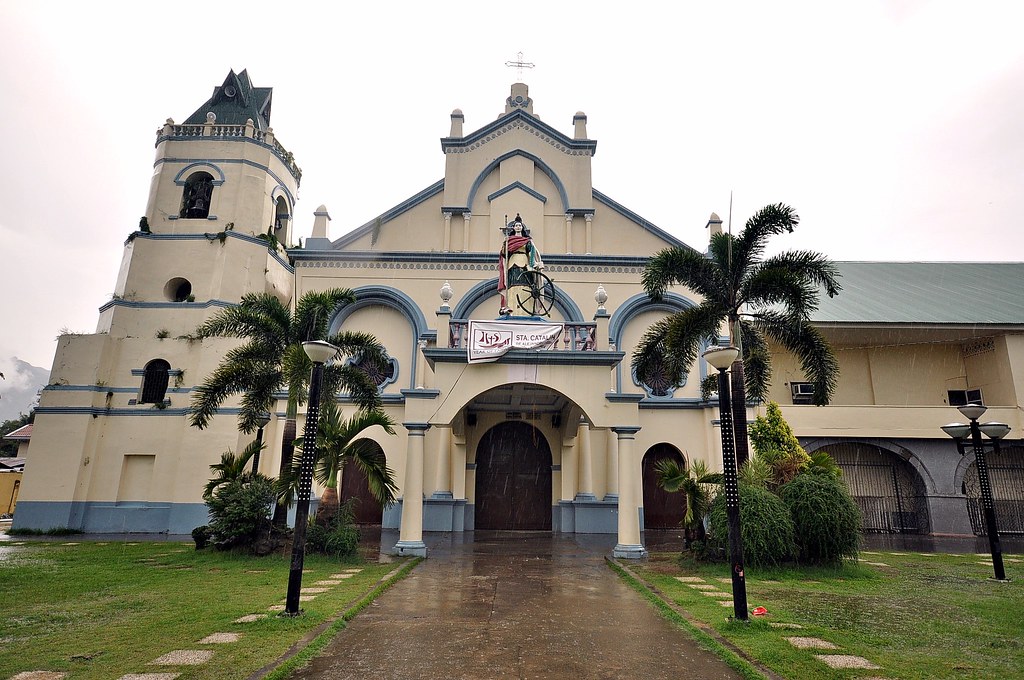 |
| Wawa Dam |
Admittedly, the title isn't mine. However, I give credit to the owner of the concept. Either it was Tim Delez or Mabel Tenorio or the organizer of the tour, Edgar Canete. Some members of AHP and some of their friends decide to get away for a Sunday and visit the town of Montalban. The small group composed of: Pheeyah Salones, Mafe Dajalos, Dennis Geronimo Red Maristany, Jam Ki, Tim Delez, Mabelle Tenorio, Maricar Anatalio, Edgar Canete, Lopa Equitad, Arlene Arguel Cejar, Presy Vivar, Lydia Canlapan, Leah Mina Caliboso, Esquierdo Bhel Asinas, Allan Pardilla Martiinez. I hope I didn't leave anybody out...
 |
| Nstra. Sra. de Aranzazu church |
We decided to get together and take up Edgar's long-standing invitation to experience his hometown. Along the way, we visit the Church of Nstra. Sra. de Aranzazu, a japanese temple, Eulogio Amang Rodriguez' heritage home, and finally Wawa Dam where we get soaked to the skin to get rid of the heat and much on simple food lovingly prepared by Edgar's Family. To rinse off we went to Edgar's home in Montalban adn finally head home to Manila. But I'm getting ahead of my story...
 |
| Nstra. Sra. de Aranzazu knave |
This trip was one for the books. I woke up early for the 5 a.m. call time at Mc Donald's Centris. Some members were late (as is normal in these meet ups) so we finally reached the first item on the itinerary. The Nstra. Sra. de Aranzazu in Marikina. I first became aware of the Nstra Sra. de Aranzazu at the Grand Marian Procession held in Intramuros. I see her yearly every time I make an attendance at the procession. So to visit the shrine was a first for me. As it turns out Arlene Cejar was a church volunteer here in her younger years. We were met and welcomed by elders of the church ministry and toured around the church after a Mass celebration. After the orientation, we went up the choirloft and tried to make it to the belfry. Unfortunately, the entry was locked up and so we failed to go see the original church bells. After the obligatory photo ops, we then proceeded to the Japanese temple.
 |
| Japanese Temple |
The temple required us to walk uphill for some 5-10 minutes. Once we got to the site, it was easy to see why they would decide to build a temple in the area. It had a clear view of the mountains in front of the temple entrance. at the back of it was a vista of the Quezon City area. The temple is completely abandoned. A pity really, as it is made of sturdy construction material: poured concrete in a dome-like structure with portholes and an exterior stairway leading to a circular view deck. On the very center of the exterior dome is a square baluster that probably serves as a look out. The interior was cool probably due to the molded poured concrete with a recessed altar at the very center. The acoustics were amazing. It perplexes me why it was totally abandoned. I could totally convert it into a home... or at the very least, a cafe...
 |
| viewdeck of abandoned Japanese temple |
Montalban was a delight to re-visit. I remember going there during a few summers in my youth when we would stay at my cousins in Pasig. That was the nearest area to go to. Back then, there were no thriving communities in the area. It was sparsely populated and a few enterprising families would peddle snacks and soda which they allowed to cool in the running streams in the area. Yeah... I am old. The place is highly populated now and the tourism draw in the area is highly developed. The trek to the wawa dam was an easy one. so when we got to the area, it was mid day and quite a few groups were already enjoying the rushing water. beware of the slippery dam. Years of accumulated moss can be dangerous. The rushing water can be therapeutic if you stay there long enough.
 |
| Wawa dam |
By 11:30, we went further uphill to have lunch in the resrrvoir where we feasted on grilled milkfish, eggplant served three ways: omelet, grilled and steamed. steamed okra and camote tops, crispy biya, salted egg, and leche flan and mango ice cream for dessert. The bamboo rafts drifted along the river while lunch was going on and so it nearly lulled me to sleep after eating a large meal.
 |
| rafting on the dam |
By half past two we needed a good rinsing from the river and headed to Edgar Canete's home. While admiring his abundant blooms, we had merienda of Ginataa'ng bilo bilo, fried bananas and fresh coconut water gathered from his trees. Oh my, I must have eaten a three days' meal worth of food. I got home really tired so i ended up falling asleep on the couch while restiing my tired legs from walking and climbing all day....
 |
| Ginataang bilo bilo |
This trip was epic fun...
 |
| Eulogio Amang Rodriguez heritage house |




























